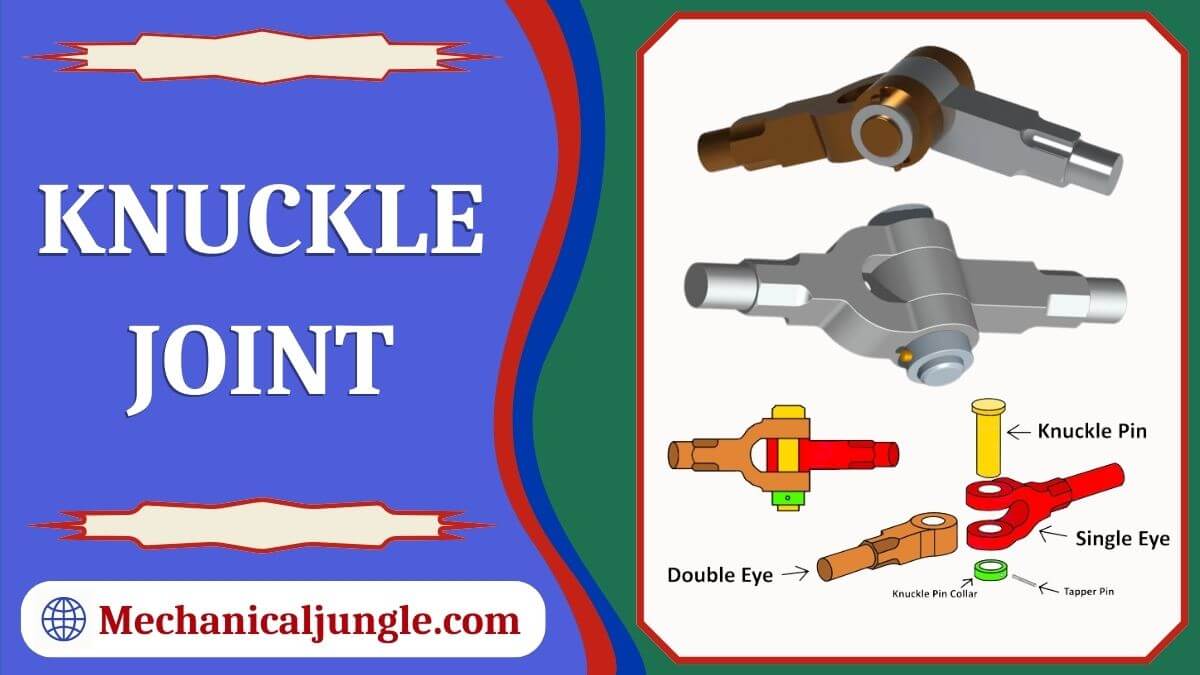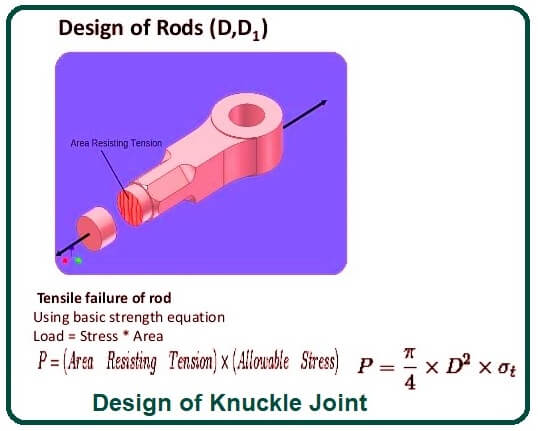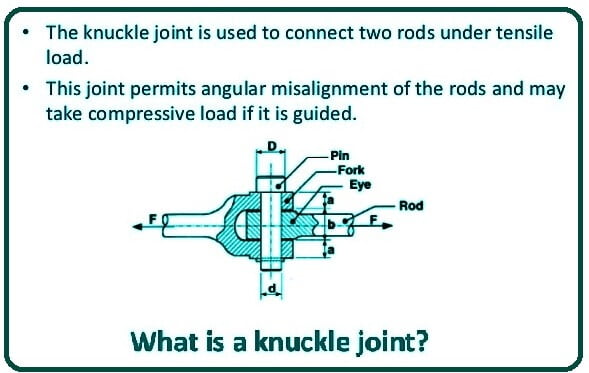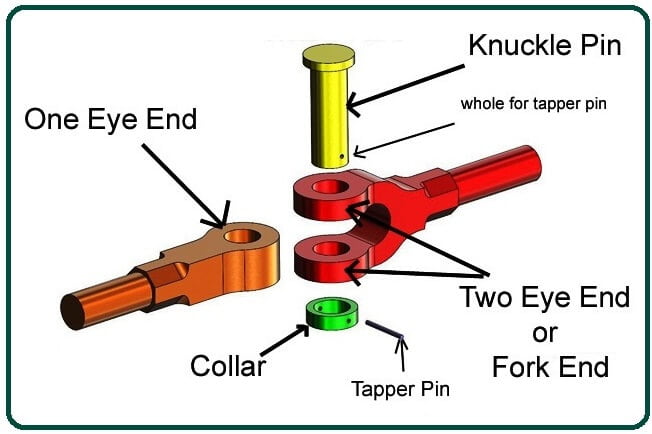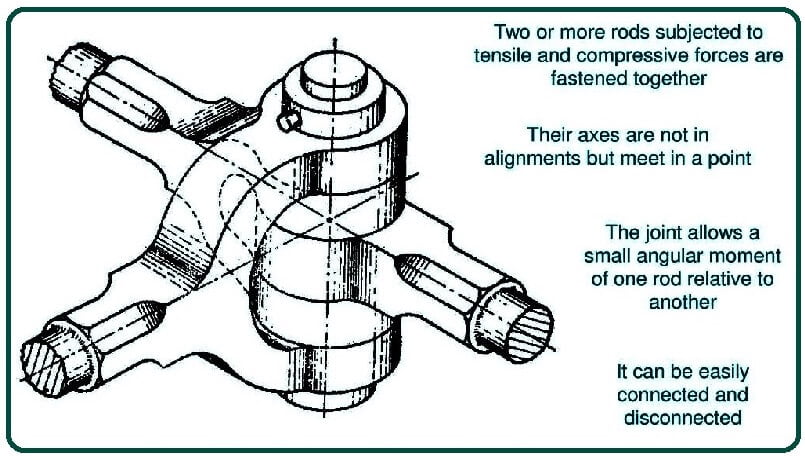Design of Knuckle Joint:
- Material selection:- As the joint is subjected to reversible stress, then the induced stress will be repeated, and the joint may fail due to fatigue. Therefore the material is selected considering low carbon steel, which will withstand the stresses developed in the above case, and the cost of the material will be within the limit.
- Material properties:- So select C-30 as the material for all parts [Hint: we can choose between C-15 to C-45]
- Permissible stresses:- Maximum principal stress, shear stress, Imperial relation.
- Design of rod:- Consider the rod is subjected to a direct tensile stress ς = P / π d2
- Design of knuckle pin.
- Design of single eye end.
- Design of double eye end.
- Miscellaneous Dimensions:- pinhead diameter and pinhead thickness.
What Is a Knuckle Joint?
A pore joint is a joint pin used to join two components that are loaded under tension. One component has a fork with holes on either side, forming a double eye, while the other component has one eye.
The single eye is inserted between double eyes so that all three holes are centered, and a pin is used to secure components.
Pore joints are often used to connect rods that are subject to stress in structures such as roof tiles, bridges, and cranes. A chain link is also considered a chain of pore joints. Simplicity means that the pore joints are easily manufactured while being strong and rigid under stress loads.
They are also easily assembled and dissatisfied. The ability to allow some rotations can be advantageous in truss structures because it ensures that the structural members remain under a net stress load and are not subject to bending moments, which can increase the stress.
Knuckle joints always have a fork end, an eye end, & a pin. Typically, these are all specially manufactured parts, although standard rod ends are sometimes used for the ends of the eye.
This has the advantage that a rod endpin makes some additional rotational motion perpendicular to the axis, providing protection from bending stresses.
Different types of pins can also be used. The most common is a special pin with a shoulder at one end & a cross hole at the other to accept a collar & split pint. For larger structures, such as bridges, cold rivets were historically used. The axle can also be bolted.
A finger joint is a type of freedom (1-DOF) kinematics pair called an inverted joint or pin joint. This means that it allows only relative rotation about the single axis.
All translations, as well as any other axis, are prevented from moving about. Other names for the type of joint are pivot points or hinges when analyzing motion in two dimensions.
A pore joint is a type of joint that connects two cylindrical rods whose axes lie on the same plane and under tens of loads. It is used to transmit axial tensile force. This joint allows the angular movement of two cylindrical rods in one plane.
The finger joint is named because it uses a knuckle to connect two cylindrical rods.
Parts of the knuckle joint:-
- Two rods are to be connected.
- Eye end.
- Double Eye End or Fork End.
- Knuckle Pin.
- Collar.
- Tapers Pin or Lock Pin or Split Pin.
Construction of Knuckle Joint and Functions of Different Parts:
- The finger joint is used to connect two rods in which one rod has one end of the eye, and the other rod has two ends of the fork. These heads are given a name and have two eye ends because one of them has a hole, and the other has two holes.
- The end of one eye is placed between two eye ends or two eyes of a fork. After that, a nozzle pin is inserted at the end of the eye and the end of the fork. The fork pin is used to hold the fork end and eye end together.
- Some part of the knuckle pin comes outside of the lowermost hole of the fork end.
- There is a small hole under the knuckle pin. Collar and tamper pins are used to lock the knock pins at the ends of the eye and fork.
- The collar has two holes, and the collar is placed in such a way that the hole of the knuckles is attached to the collar hole, and after that, a taper pin is inserted from the collar hole into the collar hole.
- In this way, a finger joint is formed. Some part of the knuckle pin comes outside of the lowermost hole of the fork end.
Failure of Knuckle Joints:
Failure of finger joints can lead to accidents, so it is necessary to design finger joints to withstand stress without failure.
The modes of failure are:-
- Shear failure of knock pin (single shear).
- Crush the pin against the rod.
- Tensile failure of flat end bars.
- Tensile failure of a solid rod.
- Finger pin bending,
- Finger pin single eye or tensile failure in rod and hole.
- Failure beyond single eye end shear pinhole (double shear).
- She is bending the pin into the pinhole of the knuckles of one eye.
- Tensile failure of double eye end at finger pinhole.
- Double-eye end shear failure beyond the pinhole of the nose.
- Failure of the pin at the knuckle pinhole of the end of the double eye,
Application of Knuckle Joint:
The following are knuckle joint applications:-
- The joint between the tie rod joints of a roof truss.
- Joint stress link in bridge structure.
- Tie rod joint of the jib crane.
- Link of roller chains, bicycle chains, and watch chain straps.
- Connecting rods between locomotive wheels.
- The valve mechanism of a reciprocating engine.
- The fulcrum for the lever.
- The knuckle joint is also used in wheel alignment parts of tractors.
- In an automobile, a finger wheel supports the skeleton for assembly.
- This eccentric flush work, on some occasions, uses a downward string such as barrel steps, lateral drilling, re-entry into the bottom of the well, fishing, and so on.
- Knuckle joints are mainly used for jointing in rail compartments.
- It is used in the vehicle’s windshield wipers.
- It is also used in robotic arms or earthmovers such as grains or tanks.
Advantages of Knuckle Joint:
The advantages of knuckle joints are as follows:-
- The Knuckle joint can withstand large tensile loads.
- It has good mechanical rigidity.
- It is simple to manufacture and install.
- It can be easily assembled and disintegrated.
- The design is simple and easy.
- Lesser parts are less expensive and more reliable.
- This may allow angular movement between the rods.
- High repetition accuracy even with material thickness and tensile strength.
- Impact reduction and high system rigidity.
- Long tool life.
The Disadvantage of Knuckle Joints:
The disadvantages of knuckle joints are as follows:-
- This joint cannot withstand large compressive loads.
- This allows angular movement in only one plane.
- It is not as flexible as a universal joint.
Frequently asked questions (FAQs) that could complement your article on knuckle joints:
What is a knuckle joint and how does it work?
A knuckle joint is a mechanical joint used to connect two rods under tension. It consists of an eye end, a fork end (double eye end), and a pin that holds them together. It allows angular movement in a single plane.
What materials are suitable for knuckle joints?
Knuckle joints are often made from low carbon steels like C-30 due to their ability to withstand repeated stresses. Materials should be chosen based on strength, fatigue resistance, and cost-effectiveness.
What are the main parts of a knuckle joint?
The main parts include the rod (connected components), eye end (single eye), double eye end (fork end), knuckle pin (connecting pin), collar, and taper pin or lock pin for securing the joint.
What are the common applications of knuckle joints?
Knuckle joints find applications in structures like roof trusses, bridges, cranes, and chains (such as bicycle chains). They are also used in mechanical linkages, valve mechanisms, and automotive components.
What are the advantages of using knuckle joints?
Knuckle joints can withstand large tensile loads, offer good mechanical rigidity, are simple to manufacture and assemble, and allow for angular movement between connected rods.
What are the limitations of knuckle joints?
Knuckle joints are not suitable for handling large compressive loads and allow angular movement only in one plane. They are less flexible compared to universal joints.
How should knuckle joints be designed to prevent failure?
Design considerations include selecting appropriate materials, calculating permissible stresses, ensuring adequate pin dimensions to prevent shear or tensile failure, and considering the application’s load conditions.
What are the maintenance requirements for knuckle joints?
Regular inspection for wear, lubrication of moving parts if necessary, and replacement of worn-out components are essential to maintain the integrity and functionality of knuckle joints.
What are the safety considerations when using knuckle joints?
Users should be aware of the joint’s load limits and ensure proper installation and maintenance to prevent accidents due to joint failure or wear over time.
How do knuckle joints compare to other types of mechanical joints?
Knuckle joints are simpler in design compared to universal joints but offer robustness in handling tensile loads. They are ideal for applications requiring straightforward angular movement in a single plane.

